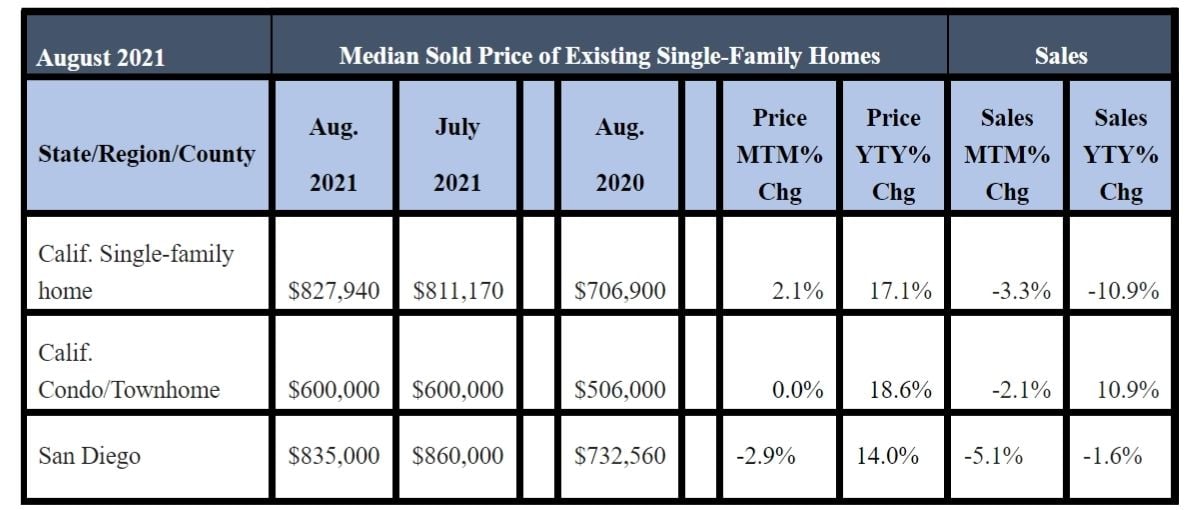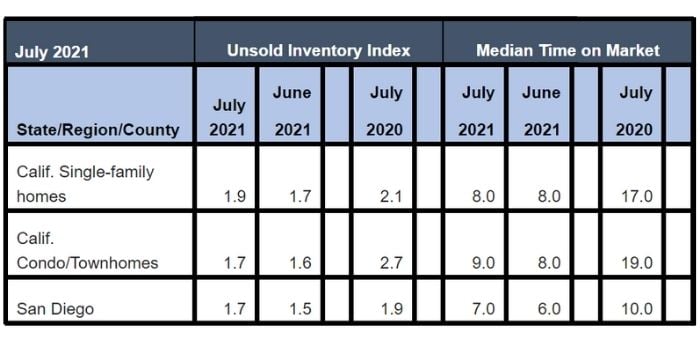
The California housing market’s home sales activity rebounded in September 2021, reversing a four-month decline. It was the state’s largest monthly increase in more than a year, according to the latest home sales and price report from the California Association of REALTORS® (C.A.R.).
Closed escrow sales of existing, single-family detached homes statewide on a seasonally adjusted annualized rate were up 5.6 percent to 438,190 in September 2021, compared to 414,860 in August 2021 and down 10.5 percent from a year ago in September 2020, when 489,590 homes were sold on an annualized basis. The statewide annualized sales figure, collected from more than 90 local REALTOR® associations and MLSs statewide, represents what would be the total number of homes sold during 2021 if sales maintained the August pace throughout the year. It is adjusted to account for seasonal factors that typically influence home sales.
The month-to-month increase from August to September 2021 was the largest since August 2020. In addition, statewide sales maintained a 16.8 percent increase on a year-to-date basis.
In San Diego, home sales in September 2021 declined 2.1 percent, compared to August 2021, and were 10.4 percent lower than September 2020.
Meanwhile, California’s median home price declined to $808,890, down 2.3 percent from $827,940 in August, when a record price was set. The September price was 13.5 percent higher than the $712,430 recorded last September. The median price in California remained above the $800,000 benchmark for the sixth consecutive month but the double-digit, year-over-year price gain was the smallest in 14 months.
September 2021 County Sales and Price Activity
(Regional and condo sales data not seasonally adjusted)
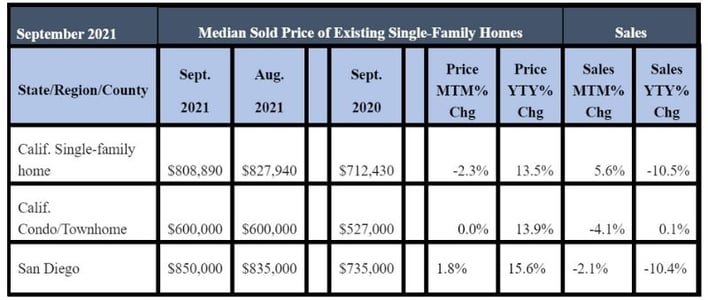
A change in the mix of sales, once again, played a role in the change in the statewide median price, as the sales share of million-dollar continued to shrink on a month-to-month basis, and prices in the high-end market increased at a slower pace than the low-end market over the past two months.
In San Diego, home prices continued to soar with the median price for a single-family detached home in September 20201 was $850,000, which was 1.8 percent higher than the August 2021 price of $835,000, and 15.6 percent higher than a year ago when the price in September 2020 was $735,000.
“As we move into the off-homebuying season, we should see market competition easing and home prices moderating, giving those who waited out the highly competitive market earlier this year an opportunity to revisit buying,” said C.A.R. President Dave Walsh. “Interest rates are expected to remain low and the availability of homes for sale should improve, which should boost homebuying interest and spur sales.”
“With the economic recovery remaining on course but progressing at a pace slower than anticipated, rates are expected to rise modestly in the next few months but will remain low,” said C.A.R. Vice President and Chief Economist Jordan Levine. “While statewide home sales are expected to dip slightly next year according to our latest forecast, housing demand will remain solid and post the second-highest level of sales in the past five years. The market will stay competitive in 2022 as the normalization continues, and home prices will remain elevated.”
Other key points from C.A.R.’s September 2021 resale housing report include:
-- At the regional level, sales in all five major regions dipped on a year-over-year basis in September. All but 10 of 51 counties posted a year-over-year decrease in closed sales in September.
-- Median prices in all major regions continued to grow on a year-over-year basis. The San Francisco Bay Area had the largest jump (21.7 percent) of all regions, followed by the Central Valley (15.4 percent), Southern California (15.0 percent), the Central Coast (5.8 percent), and the Far North (5.7 percent).
-- Home prices continued to exhibit strong growth from last year, with 44 out of 51 counties showing a year-over-year gain from 12 months ago, and 38 of them increased more than 10 percent from last September.
-- California’s housing supply leveled off in September as the market transitioned into the off-season. Orange County had a 46.3 decline in active listings. The dip in new active listings could be due to seasonality.
-- Market competitiveness cooled slightly in September. Six out of 10 homes (62.2 percent) sold above asking price, but it was the lowest level since February 2021. Still, September was the 12th consecutive month since September 2020 that more than half of the homes sold above asking price. In August 2021, 67 percent of homes sold above asking price. In July 2021, 70 percent of homes sold above their asking price.
September 2021 County Unsold Inventory and Days on Market
(Regional and condo sales data not seasonally adjusted)
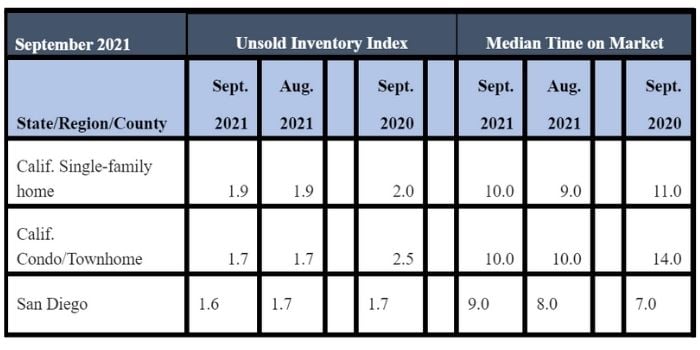
-- Statewide, the unsold inventory of available homes for sale was unchanged at 1.9 months for September, August, and July, and slightly below the September 2020 level of 2.0 months. Inventory levels measured in months indicate the number it would take for the available supply of homes on the market to sell out given the current rate of sales.
-- In San Diego County, the inventory of available homes for sale in September 2021 was 1.6 months, compared to 1.7 months in August 2021 and July 2021, as well as September 2020.
-- The median number of days it took to sell a California single-family home in September 2021 was 10 days, which compares to nine days in August 2021 and 11 days in September 2020. The 10-day figure compares to eight days in July and June and seven days in May and April. Before setting record low numbers this year, the previous statewide record was nine days in November 2020.
-- In San Diego County, the median number of days an existing, single-family home remained unsold on the market was nine days in September 2021, which compares to eight days in August 2021 and seven days in September 2020. The nine-day figure compares to seven days in July 2021, six days in June 2021, seven days in May 2021, six days in April 2021 and March 2021, and seven days in February 2021 and January 2021. The median represents a timeframe when half the homes sell above it and half below it.
-- The 30-year, fixed-mortgage interest rate averaged 2.90 percent in September, up from 2.89 percent in September 2020, according to Freddie Mac. The five-year, adjustable mortgage interest rate was an average of 2.45 percent, compared to 2.98 percent in September 2020.









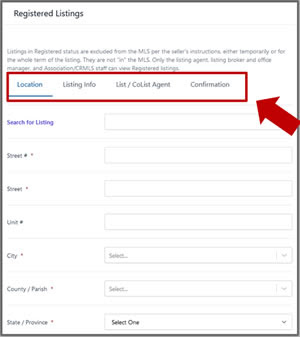







 "Testing refers to the use of individuals who – without any bona fide intent to rent or purchase housing, purchase a mortgage or vehicle loan, or patronize a place of public accommodation – pose as prospective renters, borrowers, or patrons for the purpose of gathering information. This information may indicate whether a provider is complying with federal civil rights laws. The primary focus of the Section's Fair Housing Testing Program has been to identify unlawful housing discrimination based on race, national origin, disability, or familial status in violation of the Fair Housing Act. The Section also has responsibilities to enforce Title II of the Civil Rights Act of 1964, the nation's public accommodations law; the Equal Credit Opportunity Act, which prohibits discrimination in credit; and the Servicemembers Civil Relief Act, which provides protections for military members as they enter active duty. The Fair Housing Testing Program also conducts testing under these statutes, as well as under the Americans with Disabilities Act, which is enforced by the Disability Rights Section of the Civil Rights Division."
"Testing refers to the use of individuals who – without any bona fide intent to rent or purchase housing, purchase a mortgage or vehicle loan, or patronize a place of public accommodation – pose as prospective renters, borrowers, or patrons for the purpose of gathering information. This information may indicate whether a provider is complying with federal civil rights laws. The primary focus of the Section's Fair Housing Testing Program has been to identify unlawful housing discrimination based on race, national origin, disability, or familial status in violation of the Fair Housing Act. The Section also has responsibilities to enforce Title II of the Civil Rights Act of 1964, the nation's public accommodations law; the Equal Credit Opportunity Act, which prohibits discrimination in credit; and the Servicemembers Civil Relief Act, which provides protections for military members as they enter active duty. The Fair Housing Testing Program also conducts testing under these statutes, as well as under the Americans with Disabilities Act, which is enforced by the Disability Rights Section of the Civil Rights Division."